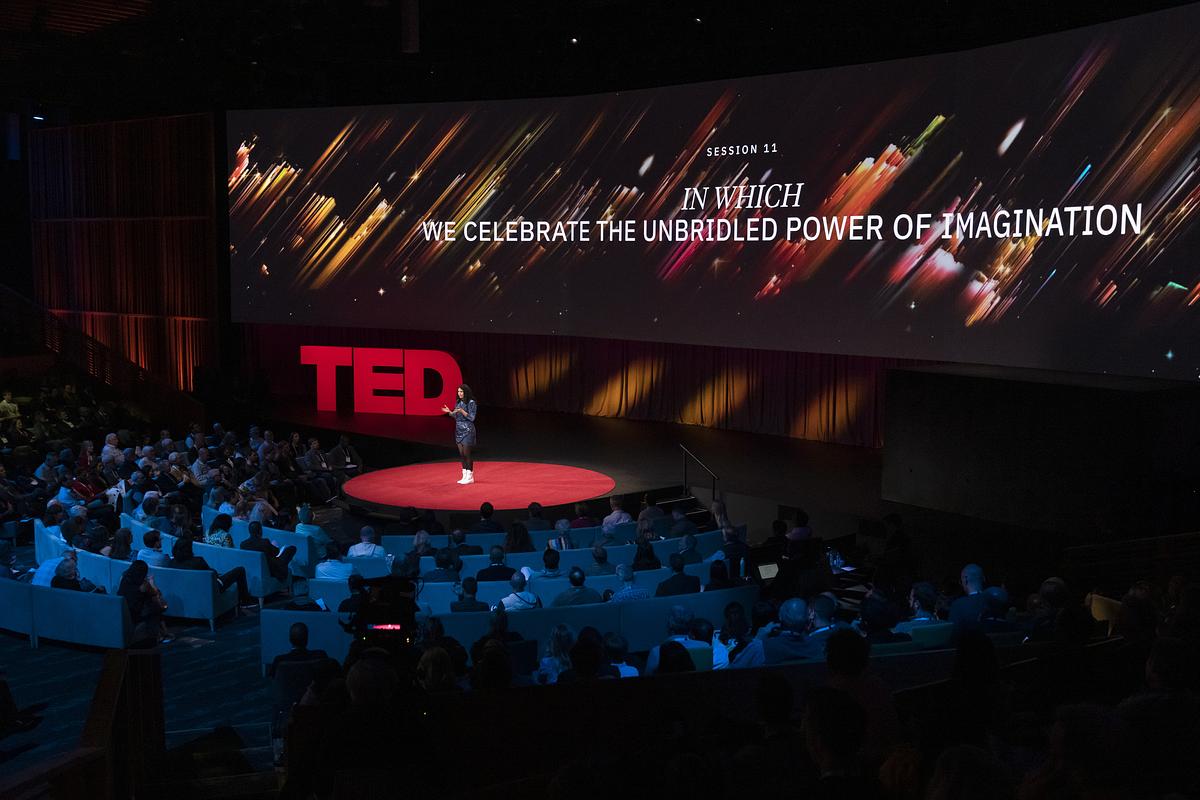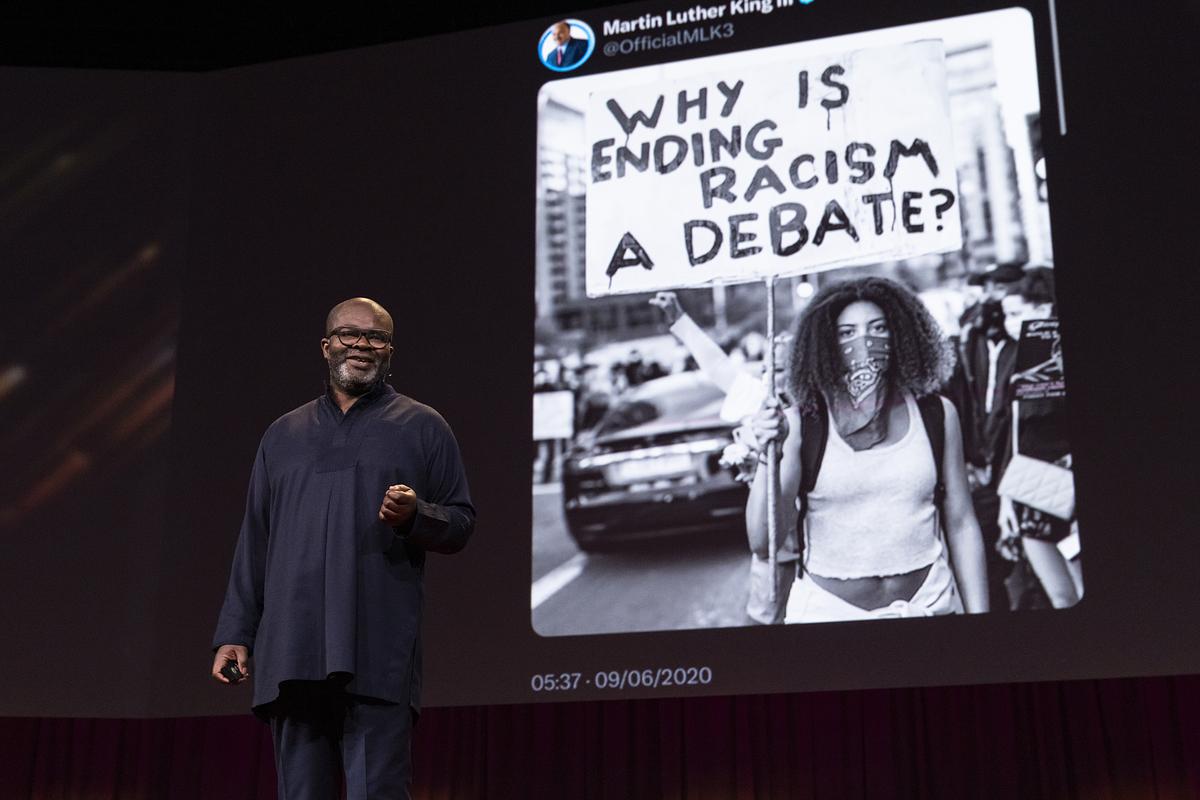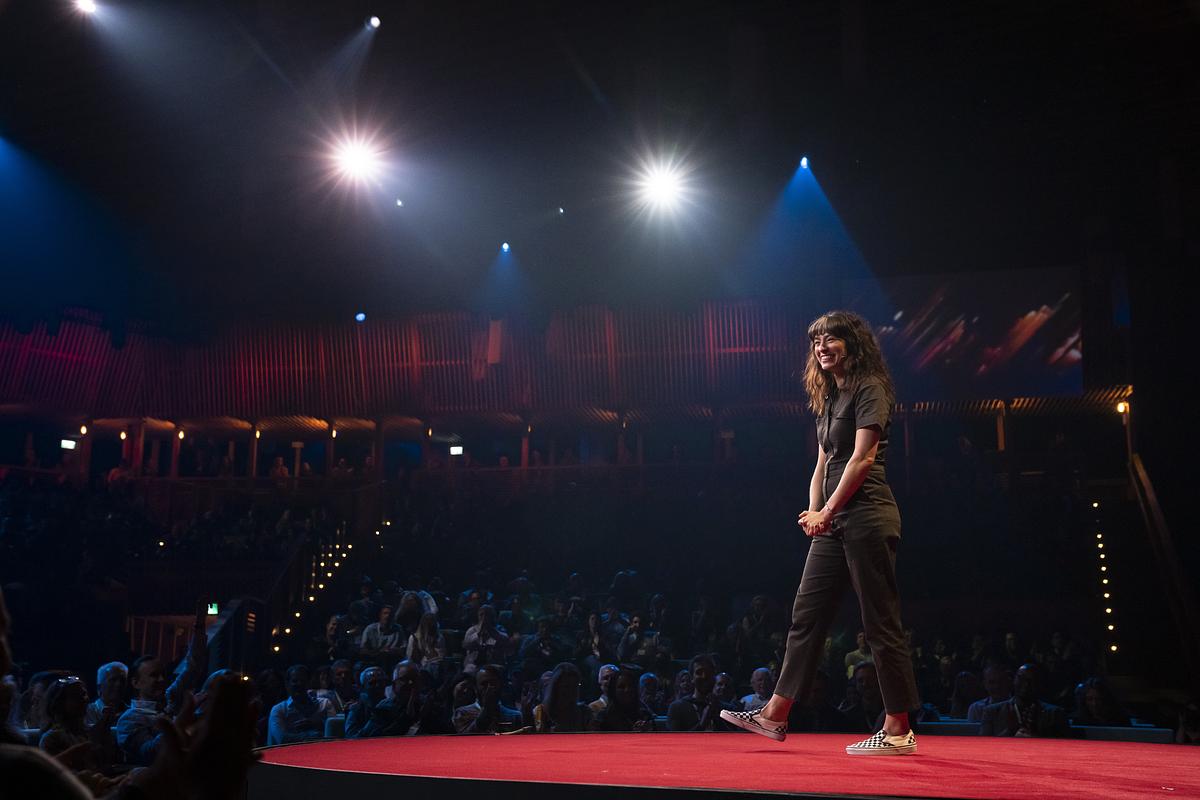
Poet Sarah Kay co-hosts Session 11 of TED2023: Possibility on April 20, 2023, in Vancouver, BC, Canada. (Photo: Gilberto Tadday / TED)
Session 11 of TED2023 was a celebration of the unbridled power of imagination. What is imagination, exactly? According to poet and session co-host Sarah Kay, it’s the ability to notice, see and observe what is — and then to dream, build and expand on what is not but could be. Eight speakers and one performer led the way in doing just that for this classically eclectic evening session.
The event: Talks from Session 11 of TED2023: Possibility, hosted by poet Sarah Kay and TED’s head of curation Helen Walters
When and where: Thursday, April 20, 2023, at the Vancouver Convention Centre in Vancouver, BC, Canada
Speakers: Lonneke Gordijn, Vinu Daniel, Misan Harriman, Melissa Villaseñor, Imran Chaudhri, Lucas Rizzotto, Ersin Han Ersin
Opening poem: Poet Sarah Kay shares some of the amazing things she sees “wandering the streets of Bewilderville” in New York City, encouraging us all “to pick up when the universe calls.”
Performance: A self-described “dance floor demon,” singer-songwriter Tolliver rocks the house with a performance of “Say What” and “I’m Nervous.”
The talks in brief:

Experiential artist Lonneke Gordijn speaks at Session 11 of TED2023: Possibility on April 20, 2023, in Vancouver, BC, Canada. (Photo: Jasmina Tomic / TED)
Nature is never static, says experiential artist Lonneke Gordijn, whose work with creative partner Ralph Nauta is informed by that principle. Together they’ve created artworks that evoke nature and border on magic, founding Studio Drift to tap into the world’s mysteries. Gordijn describes Shylight, an installation of lights that float down from the ceiling, opening and closing, interacting like flowers, and how it became an ongoing art piece exploring different mechanisms and rhythms that spark different reactions in their audience. Fascinated by murmurations (creatures going places, leaderless, moving together), Gordijin shares the evolving process of their research-backed, software-driven environmental art piece made of a building-sized swarm of drones that flew across the desert at Burning Man, enchanting all. Unexpectedly, she reveals a massive block of concrete hiding in the shadows of the TED Theater, as — like magic — it becomes weightless and begins to float over Gordijn … over the audience … almost like it came to life and was trying to find its way back home.

Vinu Daniel speaks at Session 11 of TED2023: Possibility on April 20, 2023, in Vancouver, BC, Canada. (Photo: Jasmina Tomic / TED)
What if we could put waste to work building a better world? Climate-responsive architect Vinu Daniel is doing exactly that, having developed new, natural building techniques that utilize local, discarded materials such as plastic, tires and mud to create magnificent yet utilitarian spaces. His design firm, Wallmakers, builds dreamlike homes, schools and more that blend with the landscape, showing what’s possible when we build with our planet in mind.

Misan Harriman speaks at Session 11 of TED2023: Possibility on April 20, 2023, in Vancouver, BC, Canada. (Photo: Gilberto Tadday / TED)
Given a warm video introduction by his friend, Duchess of Sussex Meghan Markle, arts advocate Misan Harriman‘s love for rich cultural experiences was ignited in his youth by the internet. It was an “endless library of the extraordinary,” he says, especially for a dyslexic Nigerian boy like himself who felt under-stimulated in his boarding school classes. Harriman went from observer of content to artist after he saw an image of Coretta Scott King at the funeral of her late husband Martin Luther King Jr. — it showed him that photography had the power to expose the work we need to do in this life. When George Floyd was murdered, Harriman took his camera to the protests that erupted in London and captured one of the greatest civil rights movements in our lifetimes — and Martin Luther King III shared one of his images on social media and millions saw what his work illuminated. Pointing to the hunger crisis in the Horn of Africa, he urges us all to take an unflinching look at what needs to be done in the world around us — and then do something.

Melissa Villaseñor Session 11 of TED2023: Possibility on April 20, 2023, in Vancouver, BC, Canada. (Photo: Gilberto Tadday / TED)
While Saturday Night Live alum Melissa Villaseñor earned comedic success through her uncanny celebrity impressions, too often she felt the laughs weren’t for her but rather for the characters. She shares how she learned to combine personal vulnerability with her classic voice bits (think: Sandra Bullock, Britney Spears, Dolly Parton and many more), centering her identity and family story on stage. Through her touching, hilarious journey, Villaseñor encourages everyone to be themselves and believe in their dreams — even if you don’t know what to do after you achieve them.

Imran Chaudhri speaks at Session 11 of TED2023: Possibility on April 20, 2023, in Vancouver, BC, Canada. (Photo: Gilberto Tadday / TED)
From the desktop computer to the laptop to the smarthphone to the smartwatch, in recent decades our devices have grown smaller and more powerful. User experience visionary and Humane cofounder Imran Chaudhri says the next step in this progression will be far more radical. Using the power of AI, our devices will disappear completely, and the human-technology relationship will become “screenless, seamless and sensing.” To make his point, Chaudhri previews his company’s unreleased device, which sits in his breast pocket and can translate his words — and voice — into French, ask for local shopping suggestions and assess if a chocolate bar meets his dietary restrictions. He forecasts a future where AI-powered tech will do away with screens, helping us to be more present and efficient in our everyday lives.

Lucas Rizzotto speaks at Session 11 of TED2023: Possibility on April 20, 2023, in Vancouver, BC, Canada. (Photo: Jasmina Tomic / TED)
What is the relationship between art and technology? In the past, says mixed reality experiential artist Lucas Rizzotto, artists often imagined new realities that engineers later built (think of the influence of sci-fi writers, for instance). But as powerful technology grows more accessible, Rizzotto wants to reverse this formula by encouraging artists to express themselves through technology — because it’s perspective, even more than technical skill, that leads to a vision worth creating. He shares how his own free-ranging exploration has led to various unexpected and delightful innovations: a suit you can play like an instrument and a game for lonely people now being adapted as group therapy. “When you take the technology we don’t understand and approach it as an artist, you do things a conventional engineer would never do,” Rizzotto says.

Ersin Han Ersin speaks at Session 11 of TED2023: Possibility on April 20, 2023, in Vancouver, BC, Canada. (Photo: Jasmina Tomic / TED)
What’s it like to be a tree — to host a vast web of relationships that anchor an entire ecosystem? In a mind-blowing talk, artist Ersin Han Ersin asks us to step into a giant sequoia tree, peering through its bark into the tapestry of life within. He gives a tour of his multisensory, mixed-reality installations — co-created with the art collective Marshmallow Laser Feast along with teams of scientists, programmers, structural engineers and more — and shares how they explore the concept of umwelt, or the unique sensory world of different organisms. The work is an effort to rethink the primordial relationship between plants, animals and fungi — and to dismantle the myth of human separation from the natural world. “We are as much trees as trees are us,” he says.